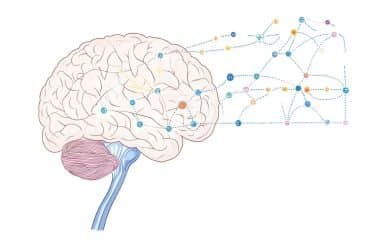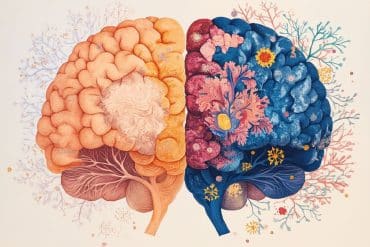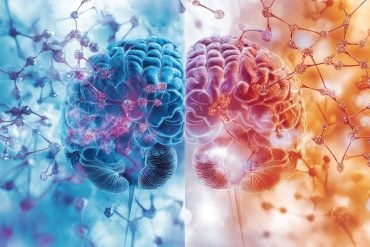If you’ve ever found a banana overtaken by a swarm of tiny flies, you were in fact witnessing an orgy of amorous Drosophila melanogaster. These trespassers engage in fervent courtship and mating atop ripe fruits, and the sex is anything but casual. In particular, male flies are very precise in choosing whom to court–a complex and intuitive decision that has fascinated scientists for more than a century.
Now, a team of Rockefeller University researchers has explored in detail how the wiring of the male fly brain enables him to assess the suitability of a potential partner and instinctively decide whether to pursue or abandon her. In a recent study, they traced the neural circuits that convey signals from a fly’s sense organs into higher brain areas and make him able to integrate different features of a potential partner. The research, published in Neuron on August 13, offers new glimpses into the biological basis of decision making.
Before an ardent male Drosophila starts courting a female, he taps her with his front leg. “This allows him to taste the pheromones she carries on her waxy cuticle and thereby tell whether she’s appropriate and likely to be receptive to his courtship advances,” explains senior author Vanessa Ruta, Gabrielle H. Reem and Herbert J. Kayden Assistant Professor and head of the Laboratory of Neurophysiology and Behavior.
If the female passes the test, the male starts trotting after her with one wing off to his side, and by vibrating the wing he sings her a courtship song. Soon after–if the object of his serenade allows it–he mounts her to couple.
Earlier research has shown that a type of brain cell called a P1 neuron plays an important role in the male fly’s courtship decision. Until now, however, scientists knew little about how this cell population receives different types of sensory information and integrates it to produce a behavioral switch.
In their current study, the researchers show that P1 neurons receive input from at least three other nerve cell groups that transmit different–and sometimes contradictory–inputs. On the one hand, if the male tastes certain pheromones on the female, his arousal is triggered. On the other hand, he may simultaneously receive off-putting odor or taste signals from the female if she has mated before or belongs to a different species (or even if it turns out that the alleged female in fact is a male, which can happen).
“The beautiful thing about this system is that P1 neurons integrate all this different information, both taste and smell,” Ruta says. “Some information is exciting, some is suppressing, and his brain can combine it to form a behavioral choice.”
In one set of experiments, the researchers introduced male Drosophila to different potential partners, and monitored the activation of their P1 neurons under the microscope. “We brought in appropriate females as well as ones that had mated before, other males, and females of different Drosophila subspecies,” says postdoctoral fellow Josie Clowney, the study’s first author. “He will only court virgin females of his own species, and it’s very clear just from looking at the activity of the P1 neurons that he can tell who to mate with by both tasting and smelling the other fly.”

The researchers observed that the P1 neurons get activated only when the male tastes and smells a female that carry the correct pheromones. They then mapped the neural pathways that bring taste and smell signals into the fly’s brain, and found that these circuits come together and are integrated by P1 neurons themselves.
Ruta notes that research into Drosophila courtship behavior can provide important clues about how the human brain functions. “Though the Drosophila brain is a lot simpler than ours, there are basic similarities,” she says. “We are constantly making decisions after evaluating and weighing different sensory signals in the environment, some of them conflicting. The sign at a crosswalk on the corner says ‘walk’ but we see a cab barreling through–do we proceed or do we stay?
“By peering into the workings of the simpler fly brain,” Ruta adds, “we hope to better understand the basic architecture of neural circuits that integrate and assess different sensory information.”
Source: Wynne Parry – Rockefeller University
Image Credit: The image is credited to Laboratory of Neurophysiology and Behavior /The Rockefeller University
Original Research: Abstract for “Multimodal Chemosensory Circuits Controlling Male Courtship in Drosophila” by E. Josephine Clowney, Shinya Iguchi, Jennifer J. Bussell, Elias Scheer, and Vanessa Ruta in Neuron. Published online August 13 2015 doi:10.1016/j.neuron.2015.07.025
Abstract
Multimodal Chemosensory Circuits Controlling Male Courtship in Drosophila
Highlights
•P1 neurons are functionally tuned toward appropriate potential mates
•Gustatory and olfactory pheromone circuits converge on P1 neurons
•Pheromone signals are carried by parallel excitatory and inhibitory branches
•This neural architecture allows stringent and flexible control of courtship behavior
Summary
Throughout the animal kingdom, internal states generate long-lasting and self-perpetuating chains of behavior. In Drosophila, males instinctively pursue females with a lengthy and elaborate courtship ritual triggered by activation of sexually dimorphic P1 interneurons. Gustatory pheromones are thought to activate P1 neurons but the circuit mechanisms that dictate their sensory responses to gate entry into courtship remain unknown. Here, we use circuit mapping and in vivo functional imaging techniques to trace gustatory and olfactory pheromone circuits to their point of convergence onto P1 neurons and reveal how their combined input underlies selective tuning to appropriate sexual partners. We identify inhibition, even in response to courtship-promoting pheromones, as a key circuit element that tunes and tempers P1 neuron activity. Our results suggest a circuit mechanism in which balanced excitation and inhibition underlie discrimination of prospective mates and stringently regulate the transition to courtship in Drosophila.
“Multimodal Chemosensory Circuits Controlling Male Courtship in Drosophila” by E. Josephine Clowney, Shinya Iguchi, Jennifer J. Bussell, Elias Scheer, and Vanessa Ruta in Neuron. Published online August 13 2015 doi:10.1016/j.neuron.2015.07.025






